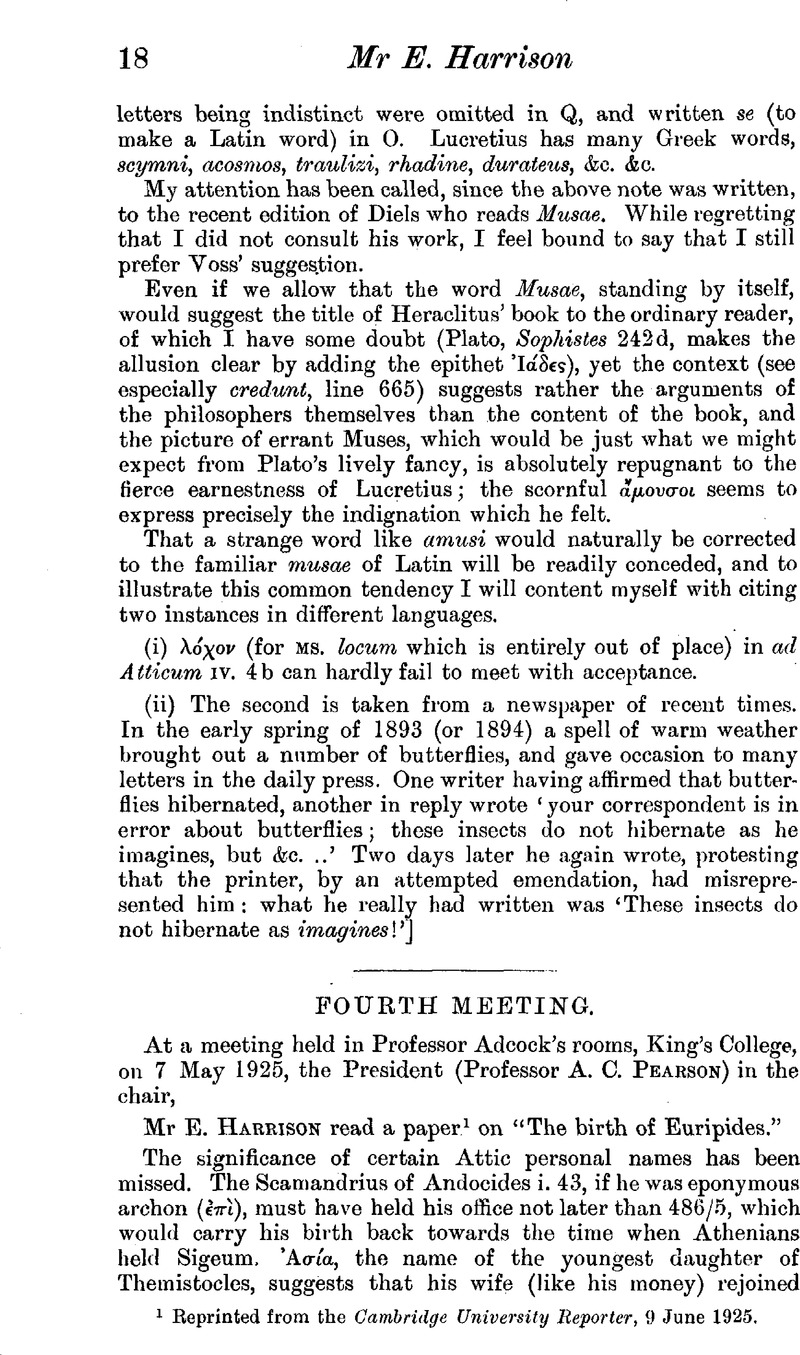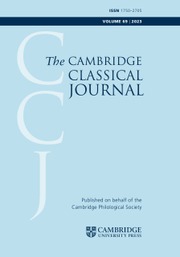No CrossRef data available.
Article contents
Fourth Meeting
Published online by Cambridge University Press: 02 April 2015
Abstract

- Type
- Lent Term, 1925
- Information
- Copyright
- Copyright © The Author(s). Published online by Cambridge University Press 1926
References
page 18 note 1 Reprinted from the Cambridge University Reporter, 9 June 1925.
page 19 note 1 Livy XXXI. 20. 7.
page 19 note 2 Livy XXVI. 47.
page 19 note 3 Livy XXXVI. 40. 12 ff.
page 19 note 4 Livy XXXIV. 52, 5, XXXVII. 59. 3.
page 19 note 5 Livy XXXVIII. 11. 8 (ambiguous): cf. Polybius XXII. 15. 8, who is explicit.
page 19 note 6 Livy XXXIV. 10. 4.
page 19 note 7 Livy XXXIII. 23. 7 and 9 and often.
page 20 note 1 Livy XVI. 13.
page 20 note 2 Livy XXII. 58: contrast Polybius VI. 58. 5 (3 minae in place of Livy's 300 quadrigati—implying that the quadrigatus is a drachm or denarius). Livy, however, probably got the word “quadrigatus” from a good source: he may not have understood it himself.
page 20 note 3 Livy XXXIV. 10. 4 and often.
page 20 note 4 Livy XLV. 43.
page 20 note 5 Livy XXXIV. 52. 5: the statement here added that it weighs about three denarii is simply wrong.
page 20 note 6 Livy XXXVII. 59. 3.
page 20 note 7 Mommsen has justly observed that the Further Province has bullion only: cp. Livy XXXIX. 42.
page 20 note 8 Livy XLI. 13.
page 20 note 9 Livy XLV. 43.
page 21 note 1 Cp. Livy XXXVI. 40. 12.
page 21 note 2 Cp. Livy XXVIII. 9, XL. 47, XLIII. 8, XLV. 4 and 40.
page 21 note 3 Cp. Livy XXXI. 4. 6 and frequently: for aeris gravis cp. Livy XXII. 33, XXXII. 26. 14.
page 21 note 4 For some justification of the views here given, see Note at end.
page 21 note 5 In the First and Second Punic Wars, possibly also after the Pyrrhic.
page 22 note 1 i.e. on the assumption that the reduced As of 5 oz. had still been nominally worth a pound of bronze.
page 22 note 2 Cp. Mommsen, , Das römische Münzwesen, pp. 302 ff.Google Scholar: cp. Livy XXII. 10 with Plutarch, , Fabius Maximus 4Google Scholar.
page 22 note 3 Cp. for prices of slaves, Livy XXXIV. 50. 6 (500 denarii), XXXIX. 44 (10,000 aeris—possibly an abnormal price): so too in donations to the troops, notably Livy XXXIV. 46 (270 aeris—27 denarii suits the time better than 67½). Cf. too price of corn: Livy XXXI. 50. 1 gives bini aeris as a very cheap price per modius: Polybius II. 15 gives 4 obols as a very cheap price per medimnus = about 5 modii. It will be seen that bini aeris = about ⅘ obol, i.e. aeris denotes asses, not sestertii. The reckoning of the denarius at 10, not 16, asses, continued after B.C. 217 in the soldiers' pay and perhaps also in these military accounts. But we must reckon with the possibility of an As of ![]() th denarius too.
th denarius too.
page 22 note 4 Plutarch equates libral As and obol (cp. Publicola 11—price of sheep ten obols—elsewhere ten libral Asses).
page 22 note 5 Mommsen lays much stress on the exact equivalence of the sestertius of B.C. 268, containing 2½ asses of 4 oz. each (Mommsen's estimate of the reduced As), to the libral pound of 10 oz. actual weight. But did the Romans commonly reckon in sestertii then? The later sestertius was of course not worth nearly a pound of bronze.
page 23 note 1 This would be part of the issue with obv. Head of Mars, rev. Eagle on thunderbolt, which is dated by Pliny the Elder to B.C 217.
page 23 note 2 See Willers, in Corolla Numismatica, pp. 310 ff.Google Scholar
page 23 note 3 e.g. the appointment of “III viri mensarii,” to control the money market, Livy XXIII. 21, the raising of a “duplex tributum,” XXIII. 30, 31, the raising of a war loan, XXIII. 48, stagnation of business, XXIV. 18, XXVI. 35, public debts paid, XXXI. 13.
page 23 note 4 lucus in urbe fuit media, laetissimus umbrae,
quo primum, iactati undis et turbine, Poeni
effodere loco signum, quod regia Iuno
monstrarat, caput acris equi.
page 23 note 5 Note particularly the remarkable resemblance of an early didrachm (ROMANO, heavy weight) to the copper coin of Beneventum, which cannot be earlier than B.C. 268.
page 24 note 1 I attribute the “quadrigati” to the period after B.C. 268, not to the Pyrrhic War, as Ridgeway thinks.




